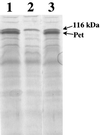Involvement of the enteroaggregative Escherichia coli plasmid-encoded toxin in causing human intestinal damage
- PMID: 10496914
- PMCID: PMC96889
- DOI: 10.1128/IAI.67.10.5338-5344.1999
Involvement of the enteroaggregative Escherichia coli plasmid-encoded toxin in causing human intestinal damage
Abstract
Enteroaggregative Escherichia coli (EAEC) strains have been shown to adhere to human intestinal tissue in an in vitro organ culture (IVOC) model, and certain strains manifest mucosal toxicity. We have recently described the EAEC plasmid-encoded toxin (Pet), a member of a specific serine protease subclass of the autotransporter proteins. When injected into rat ileal loops, Pet both elicited fluid accumulation and had cytotoxic effects on the mucosa. Furthermore, the Pet protein caused rises in short circuit current from rat jejunal tissue mounted in a Ussing chamber and rounding of intestinal epithelial cells in culture. We therefore hypothesized that the mucosal pathology induced by EAEC strains in the IVOC model was related to expression of the Pet protein. Here, we have examined the effects of EAEC strain 042 and its isogenic pet mutant in the IVOC model. 042-infected colonic explants exhibited dilation of crypt openings, increased cell rounding, development of prominent intercrypt crevices, and absence of apical mucus plugs. Colonic tissue incubated with the pet mutant exhibited significantly fewer mucosal abnormalities both subjectively and as quantitated morphometrically by measurement of crypt aperture diameter. Mucosal effects were restored upon complementation of the pet mutation in trans. Interestingly, we found that the ability of 042 to damage T84 cells was not dependent upon Pet. The data suggest that the Pet toxin is active on the human intestinal mucosa but that EAEC may have other mechanisms of eliciting mucosal damage.
Figures






References
-
- Ausubel F M, Brent R, Kingston R E, Moore D D, Seidman J G, Smith J A, Struhl K, editors. Current protocols in molecular biology. New York, N.Y: Greene Publishing Associates; 1989.
-
- Boyer H W, Roulland-Dussoix D. A complementation analysis of the restriction and modification of DNA in Escherichia coli. J Mol Biol. 1969;41:459–472. - PubMed
-
- Caffrey P, McVeigh T, Owen P. Western immunoblotting. In: Owen P, Foster T J, editors. Immunochemical and molecular genetic analysis of bacterial pathogens. Amsterdam, The Netherlands: Elsevier Science Publishing; 1988. pp. 255–266.
-
- Cobeljic M, Miljkovic-Selimovic B, Paunovic-Todosijevic D, Velickovic Z, Lepsanovic Z, Zec N, Savic D, Ilic R, Konstantinovic S, Jovanovic B, Kostic V. Enteroaggregative Escherichia coli associated with an outbreak of diarrhoea in a neonatal nursery ward. Epidemiol Infect. 1996;117:11–16. - PMC - PubMed
Publication types
MeSH terms
Substances
Grants and funding
LinkOut - more resources
Full Text Sources

